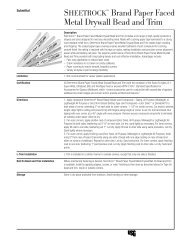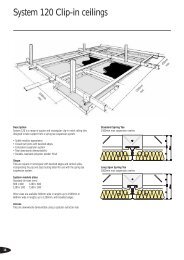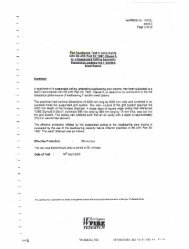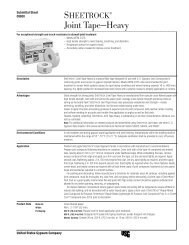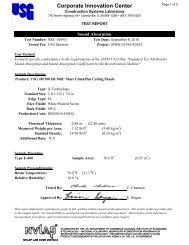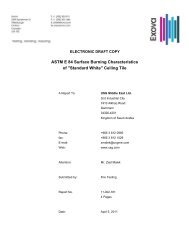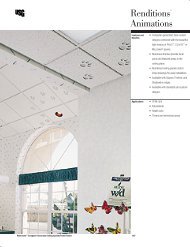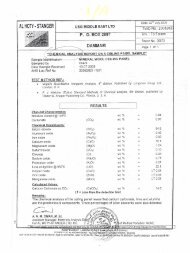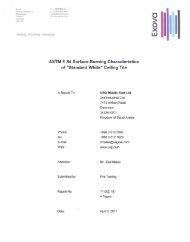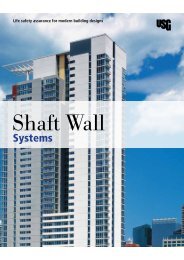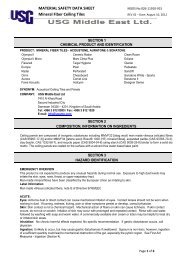Acoustical Ceiling Systems 2011 2012 - USG Middle East
Acoustical Ceiling Systems 2011 2012 - USG Middle East
Acoustical Ceiling Systems 2011 2012 - USG Middle East
Create successful ePaper yourself
Turn your PDF publications into a flip-book with our unique Google optimized e-Paper software.
22<br />
Sustainability<br />
Design that require fewer Natural resources:<br />
• Energy conservation<br />
• Raw Material Management<br />
• Waste Reduction<br />
• Safeguard against pollutants<br />
In response, many developers and owners now demand buildings that<br />
will help save energy, preserve the integrity of surrounding land and<br />
assure a clean, healthy indoor environment.<br />
1 | Indoor Environmental Quality:<br />
Indoor environmental quality (IEQ) refers to all environmental factors<br />
that affect the health and well-being of building occupants. IEQ<br />
includes such factors as Indoor Air Quality (IAQ), comfort, humidity,<br />
air exchange, acoustics and lighting quality.<br />
Many <strong>USG</strong> ceiling panels help to support healthy environments with<br />
reduced Volatile Organic Compound (VOC) emissions<br />
Formaldehyde Performance:<br />
Formaldehyde is an important industrial chemical used to make<br />
chemicals, building materials, and household products.<br />
Exposure The OSHA Permissible Exposure Limit (PEL) for<br />
formaldehyde is 750 ppb (0.75 ppm) per 8-hour TWA (Time Weighted<br />
Average, the average exposure over an 8-hour work period).<br />
Content The presence of formaldehyde must be reported if the<br />
concentration of formaldehyde exceeds 0.1 percent of weight. All<br />
<strong>USG</strong> ceilings are well below these levels.<br />
To help building professionals create healthy spaces, <strong>USG</strong> offers many<br />
ceiling panels and tiles that emit no formaldehyde or such low levels<br />
as to exceed stringent standards established by the collaborative<br />
for High-Performance Schools (CHPS). This high performance comes<br />
standard on these products, with no additional charge or lead time.<br />
<strong>Ceiling</strong> with Little or No Formaldehyde Requirements as per<br />
CHPS (Collaborative For High Performance Schools)<br />
• Zero VOC Emission for All CAST <strong>Ceiling</strong>s (level 13.5<br />
Meets Minimum Standarts<br />
Less than 50 ppb<br />
><br />
50<br />
Post-Industrial (Pre-Consumer) materials<br />
are generated by manufacturers and processors,<br />
and may consist of scrap, trimmings and<br />
other by-products that were never used in<br />
the consumer market. Post-Industrial and<br />
Pre-Consumer are one in the same under the<br />
<strong>USG</strong>BC LEED ® rating systems.<br />
Post-Consumer material is an end product<br />
that has completed its life cycle as a consumer<br />
item and would otherwise have been disposed<br />
of as a solid waste. Post-consumer materials<br />
include recyclables collected in commercial and<br />
residential recycling programs, such as officer<br />
paper, cardboard, aluminum cans, plastics and<br />
metals.<br />
Binders are derived from corn and wheat starch, which are renewable<br />
agricultural resources. The metal in many of our specialty ceiling and<br />
drywall suspension systems includes recycled content. Aluminum<br />
offers additional benefits in that it can be fully re-purposed by<br />
re-melting and salvaging the metal.<br />
Responsible Manufacturing<br />
<strong>USG</strong> ceilings = high recycled content (HRC)<br />
Recycling is only a part of the story. Careful production methods<br />
are good for the environment and increase efficiency. Our practices<br />
include:<br />
• Using clean fuels (NG)<br />
• Treating and recycling water (Saving of 300 m3 daily at <strong>USG</strong>ME)<br />
• Reducing waste (Recycling)<br />
• Offering specialized ceiling panels<br />
• Recycling old ceiling panels<br />
• Product life cycle<br />
Antimicrobial Treatments to Counter Mold<br />
C+ Superior Performance (Treatment areas in ceiling panels include<br />
face and back surfaces, as well as the formulation of the materials<br />
used to create the ceiling substrate)<br />
3 | LEED<br />
LEED ® is a guideline for building solutions established by the <strong>USG</strong>BC<br />
(United States Green Building Council) members. <strong>USG</strong> Corporation is<br />
a founding member of the U.S. Green Building Council.<br />
The Leadership in Energy and Environmental Design (LEED) is a<br />
rating system that encourages the design and construction of<br />
environmentally friendly buildings<br />
LEED was created to define “green building” by establishing a<br />
common standard of measurement and promote integrated, wholebuilding<br />
design practices.<br />
Credit are awarded based on the five key areas of human and<br />
environmental health: sustainable site development, water savings,<br />
energy efficiency, materials selection, and indoor environmental<br />
quality.<br />
Choosing zero-emitting and low-emitting ceiling products can also<br />
help earn LEED credits. Section 3.2, IAQ Management Plan, Before<br />
Occupancy, requires a total formaldehyde concentration of 50 ppb or<br />
less. As one of the largest surfaces in a space, a ceiling with zero – or<br />
low – emitting panels makes a strong contribution toward achieving<br />
valuable credits – and creating healthy, sustainable environments.<br />
Energy & Atmosphere<br />
• EA Credit 1 – Optimize Energy<br />
Performance<br />
High light reflectance (LR) of ceiling materials<br />
can reduce the Energy Consumption<br />
Materials & Resources<br />
• MR Credit 1 – Building Reuse:<br />
Maintain Interior<br />
Product Abuse Resistant surface like Cast<br />
Mineral Fiber Panels<br />
• MR Credit 2 – Construction Waste<br />
Management: Divert From Disposal<br />
Project waste (by weight) from landfill<br />
(Recycling Program)<br />
• MR Credit 3 – Material Reuse<br />
Products may contain synthetic material and<br />
metal ceilings/components<br />
• MR Credit 4 – Recycled Content<br />
Pre & Post-Consumer<br />
• MR Credit 5 – Local/Regional<br />
Materials: Extracted, Processed &<br />
Manufactured Regionally<br />
Raw materials are obtained within 500 miles<br />
• MR Credit 6 – Rapidly Renewable<br />
Materials<br />
Products may contain corn/Potato starch<br />
binders, renewable alternatives to petroleumbased<br />
binders.<br />
Indoor Environmental Quality<br />
• EQ Credit 4 – Low-Emitting Materials<br />
Products emit no formaldehyde or only a very<br />
low amount<br />
• EQ Credit 8 – Daylight and Views<br />
High LR can improve the quality and quantity of<br />
natural light by enhancing indirect lighting<br />
• EQ Credit 9 – Enhanced <strong>Acoustical</strong><br />
Performance for Schools<br />
Products used in tested assemblies may reduce<br />
sound transmission in spaces<br />
• EQ Credit 10 – Mold Prevention<br />
Products may contain ingredients that reduce<br />
the potential growth of mold<br />
Innovation<br />
• ID Credit 1 – Innovation<br />
Exception performance above LEED<br />
requirements can be awarded extra points<br />
23



